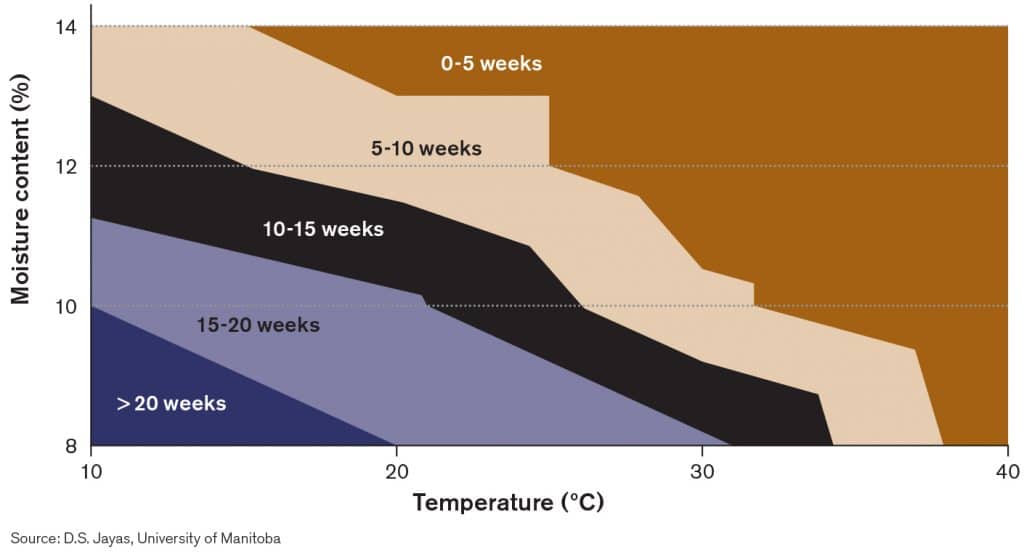Key Result
Canola keeps its high quality longer when stored at lower temperatures and with a lower moisture content.
Project Summary
Safe storage periods are similar for canola with low oil (less than 42.5 percent) and high oil content (about 45 percent). High oil content canola can be safely stored for at least 20 weeks, which was the total duration of this study, if temperature is below 25°C and moisture content is 10 percent or lower. Warmer canola has a shorter safe storage period: Canola at 10 percent moisture and 30°C can be safely stored for only six weeks.

Digvir Jayas at the University of Manitoba led the study to see if canola with higher oil content required different storage guidelines than canola with lower oil content. It included three different experiments: (1) small-scale storage; (2) large-scale storage; and (3) a physical properties study.
The small scale study compared high oil canola (NX4-105RR, 45H49, and 5440) and a standard canola variety (5525 CL) stored in 20L pails at eight, 10, 12, and 14 percent moisture content. Plastic pails were kept inside environmental chambers for up to five months. Samples were removed from the containers every two weeks and tested for germination, visible mould, and free fatty acid values (FAV). Free fatty acids increase as grain ages and deteriorates. FAV is an important index in evaluating the quality of grain.
After 20 weeks, canola with eight, 10 and 12 percent moisture stored at 10°C and 20°C did not have significant quality changes, no matter the oil content. Canola with 14 percent moisture had a considerable germination drop after just 10 weeks at 20°C. At 30°C and 40°C, germination of both high oil and standard canola varieties dropped significantly in a short time. Mould was evident in some high oil content varieties with higher moisture content stored at higher temperatures.
For the large-bin study, Nex4 105 canola moisture was loaded into three flat bottom bins inside an environmentally-controlled room. At the beginning of the study, canola was aerated with humid air to bring the seed moisture content to 10 percent. A computer system controlled room temperature and humidity to simulate Western Canadian storage conditions from September to December 2010.
Germination for canola in the top layer of all three bins dropped more than 20 percent after 16 weeks. By six weeks, visible mould appeared at the top layers of the three bins, and after 10 weeks, one bin had visible mould at all layers. Mould causes canola to heat and spoil. It can multiply fast in either tough or damp seeds at warm temperature.

Overall the physical properties study concluded that buildings strong enough for low oil canola could also support high oil canola.
More specifically, the results from the physical properties study showed that the bulk densities of both oil content varieties increased with increasing moisture contents from 8% to 10% and decreased with further increase of moisture content from 10% to 14%. However, the bulk density of high oil content canola was affected more by changing moisture content than low oil content canola. Moisture content in the tested range did not influence the repose angles very much. In general, emptying angles decreased, increased and decreased again when moisture content changed from 8% to 10%, 10% to 12% and 12% to 14%, respectively. The angles of repose of canola depend on varieties and kernel surface, and are independent of oil content. The coefficient of friction was not significantly affected by the moisture content but was by oil content, and buildings that are strong enough for low oil content canola could also support the high oil content canola.
Figure 1. Safe storage guidelines of high oil content canola.





